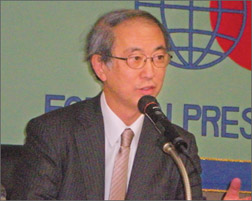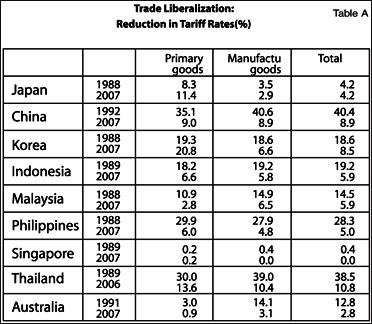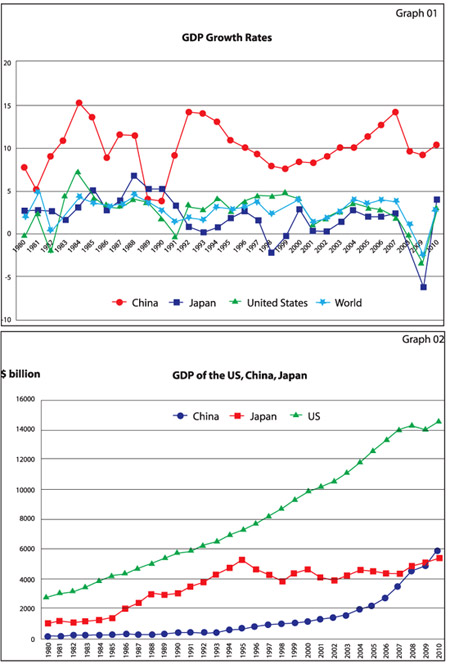Revitalizing the Japanese economy
Samangie Wettimuny
On March,11 Japan will mark the first
anniversary of 3/11 catastrophe. Here are excerpts from an interview
with Prof. Shujiro Urata of the Waseda University Graduate School of
Asia Pacific Studies, Japan held at the Foreign Press Centre, Tokyo on
Japanís economic issues, post earthquake economic recovery and the
Economic Partnership Agreements in the Asia Pacific region.
|

Prof. Shujiro Urata |
The major economic problems currently faced by Japan are low economic
growth, lack of dynamism, closed economy, declining and ageing
population, declining savings rate and growing huge government debt.
Although the Japanese economy is opening up in the recent years, still
it is largely a closed one. When considering the GDP growth rates in the
recent years, it is evident that Japanís GDP growth rate is below the
world average and below the US. Chinaís economic growth is phenomenal.
(See Graph 1) When compared to the US and China in terms of nominal GDP,
Japan was surpassed by China in 2010. Japan is number 3 in terms of
economic size after US and China. (See Graph 2)
The Japanese economy was hard hit by 3/11 disaster when the country
was affected by a massive tsunami, earthquake and nuclear radiation
leakage. However the countryís economy has not been doing quite well all
these years. As Prof. Urata said when the country was hit by the Asian
Financial Crisis in 1997-1998, the countryís economy was not only hit by
the crisis alone, but also by the increase of consumption tax that led
to deterioration in the Japanese economic performance. Currently there
are discussions on tax and social security issues and the government is
trying to raise the consumption tax. As the opponents argue the earlier
1997 experience has set a good lesson to the government not to increase
the taxes at a critical moment like this.

2008/2009 global Financial Crisis
At the time 2008/09 financial crisis initially hit the US and the
European economies, the East Asian countries including Japan were
confident that they wonít be affected as their economies were quite
stable. But the negative impacts were soon felt by the East Asian
economies mainly as a result of deduction of exports to the USA and
other European countries. In fact that led to substantial reduction in
Japanís growth rate.
Even when firm entry and exit rates are taken into consideration, it
is evident that the Japanese economy is stagnant when compared to that
of US. In the US both rates are quite high compared to those in Japan.
That means new dynamic challenging firms enter the market, and others
exiting it which leads to more dynamism. But such dynamism cannot be
observed in the Japanese economy in the recent years. (See Graph 3)
Trade - GDP ratios and FDI-GDP ratios show the openness of the
economy and as the Graph 4 shows in terms of Trade-GDP ratios Japan and
US are relatively close compared to the world average and particularly
when compared with China FDI-GDP ratio, Japan is the lowest. That is one
of the reasons for the lack of dynamism in the Japanese economy.
Japanís population started to decline in 2007. In terms of
composition of population, those aged between 15 - 64 are labeled as the
labour force and that itself started to decline from the 1990ís (1995)
and the percentage of ageing population is on the rise. The three
fundamental supply side partners needed for economic growth are increase
in labour input, increase in capital input and increase in productivity.
Here in Japan the labour inputs are declining, so unless Japan opens up
the labour market for foreign workers or immigrants, economic growth
cannot be expected from labour inputs.
 Capital inputs Capital inputs
In Japan Gross Domestic Savings (savings by domestic, government and
corporate sector) are also declining. Therefore, unless we successfully
attract foreign investment, the possibility of achieving economic growth
by increasing the capital inputs is not so likely. Hence to achieve
economic growth or maintain this living standard, it is necessary to
increase productivity.
When looking at the economic growth from the demand side,
consumption, investment, expenditure, exports-imports are taken into
account. Here what should be emphasized is that we cannot expect
government expenditure to push the economy forward as there is very
limited room for government expenditure to be increased due to huge
government debt. Government debt-GDP ratio keeps on increasing resulting
from huge government expenditure - mainly due to socially security
payments and particularly due to the 3/11 disaster. Hence the future
prospects concerning government debt-GDP ratios are not so bright.
Revitalization
ďNow giving all the problems that Japan is faced with how can we
revitalize the Japanese economy? One key element here is increasing
productivity. Unless we are successful in increasing productivity we
cannot achieve economic growth that we hope to achieve. And there are a
number of policies that the Japanese government can adhere to, to
improve the productivity and out of them opening up the Japanese economy
is a very important policy which could achieve this goal including
productivity.Ē
The role of FTAs
The DOHA development agenda under the WTO is not going anywhere. In
such a situation what could be done is opening up the economy
unilaterally, but that too is not quite easy. Hence the second best
alternative is Free Trade Agreements (FTAs) - the agreements which
eliminate tariff between the member countries. It is obviously
beneficial to Japan to enter into FTAs with Asian countries, especially
with East Asia. In recent years East Asian countries (including
developing countries) such as Japan, China, Korea, Indonesia, Malaysia,
Philippines, Singapore, Thailand and Australia experienced substantial
trade liberalization. (See Table A) For example Chinaís average tariff
rate in 1992 was as high as 40 %, but came down to 8.9% by 2007.China
entered WTO in 2001 and that of course was an important reason for
Chinaís reduction in tariff rates.However there are still high tariff
barriers, particularly for some sensitive industries. In the case of
China all the sectors still have very high tariff rates.
Although the tariff rate for Japan is quite low already, for some
agricultural products tariff rates are extremely high. The condition
shows that there is still room for further trade liberalization. As
Prof. Urata emphasized even for FDI liberalization the situation is
quite the same. Given different situations further trade and FDI
liberalization would lead to expansion of trade and investment which in
turn lead to economic growth. That is the way that world and Japan
should follow.
 The special characteristics of Japanís FTAs are trade and FDI
liberalization, facilitation, economic cooperation and improvement of
business environment (improving customer procedure- simplifying
documentation of customer procedure and so on.) Characteristics such as
economic cooperation are very important when establishing FTAs with
developing countries. Also Japanís business is very keen on having some
content which deal with business environment and particularly Japan and
Mexico FTAs exclusively deal with this improvement in business
environment and they were successful. The special characteristics of Japanís FTAs are trade and FDI
liberalization, facilitation, economic cooperation and improvement of
business environment (improving customer procedure- simplifying
documentation of customer procedure and so on.) Characteristics such as
economic cooperation are very important when establishing FTAs with
developing countries. Also Japanís business is very keen on having some
content which deal with business environment and particularly Japan and
Mexico FTAs exclusively deal with this improvement in business
environment and they were successful.
The motives behind Japanís FTA s which are also common with other
countries are to expand export market for Japanese firms, improve
investment environment for Japanese firms, obtain energy and natural
resources, promote structural reforms in Japan (in the field of
agriculture), improve and establish good relationship with other
countries and to provide economic assistance to developing countries.
External pressure is necessary to promote domestic reforms.
Impact of FTAs
A major short run effect is the trade and Foreign Direct Investment (FDI)
expansion between and among FTA members. It is important to know that
the short term impacts of FTAs such as reduced production and employment
could be negative. The expansion of imports will replace domestic
production and reduce local employment opportunities. That is why there
is a great deal of opposition to the FTAs, especially from sectors such
as agriculture. Various measures including gradual phase in
liberalization, temporary assistance to negatively affected workers,
structural reform and other policy measures can moderate the negative
impacts during the transition period.
However economic growth is a major medium to short run effect of the
FTAs. Great impacts can be expected from FTAs which have comprehensive
components such as facilitation and economic cooperation. The larger the
membership the greater the impact of the FTAs.
As Prof. Urata finally noted East Asiaís rapid economic growth has
been attributable to rapid expansion of trade and FDI, which in turn
resulted from trade and FDI liberalization. To achieve further economic
growth, further trade and FDI liberalization and facilitation would be
effective. Region wide FTA should be established: EAFTA (medium level),
CEPEA (medium level), TPP (high level FTA), and gradual liberalization
should be pursued, Then it is necessary to expand it or merge with other
FTAs to lead to global trade liberalization. FTAs can also be
established with the rest of world Ė with the US, the EU and Latin
American countries. Japan should lead CEPEA and join TPP. Japan has
shown interest in joining the TPP negotiation and is currently
conducting talks with the negotiating members.
[email protected]
|



